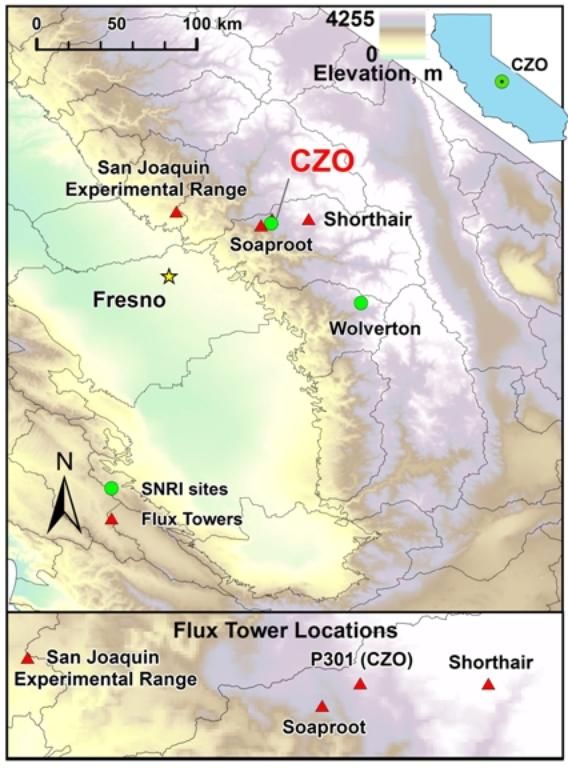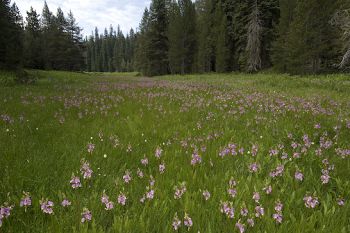Wolverton Basin (2230 - 2700 m elevation)
Wolverton Basin site in Sequoia National Park comprises meadows and forested mountain slopes.
8 km2 Area
Long Meadow in Wolverton Basin, summer. Photo by Ryan Lucas. © Southern Sierra Critical Zone Observatory
-
Setting & Research
Wolverton Creek & Long Meadow
The Wolverton basin is a snow dominated watershed located in Sequoia National Park. Ground based instrumentation in Wolverton includes meteorological, soil moisture and temperature, snow depth, solar radiation, an sap flow instrumentation on north and south facing slopes at two different elevations.
Wolverton basin is instrumented with four instrument nodes, two meteorological stations, and monitoring wells and piezometers located in Long Meadow. Additional instrumentation in Wolverton includes clustered piezometers/monitoring wells in Long Meadow, and stream flow measurements at different locations along Wolverton Creek.
Groundwater/Surface water interactions were investigated in Long Meadow, located in Wolverton, during a one week deployment in July 2008. A fiber optic cable distributed temperature sensor (DTS) was utilized for collection high spatial and temporal resolution meadow stream temperature data. Other key data collection methods included a micro-meteorological station, a large geodesic evapotranspiration chamber, Hobo temperature loggers, pressure transducers in existing monitoring well/piezometers, and water geochemistry sampling.
-
Overview Maps
Southern Sierra CZO overview map

See full size (in new tab/window)
-
Dynamic Map
To fully zoom into a small area, you may need to visit the "Map" button and uncheck "Terrain" view.
-
Data
Met Stations, SEKI Panther - Meteorology (2006-2017)
18 components • Wolverton Basin (2230 - 2700 m elevation) • Climatology / Meteorology • Peter Kirchner; Roger Bales; Erin Stacy; Xiande MengMet Stations, Wolverton - Meteorology (2006-2017)
13 components • Wolverton Basin (2230 - 2700 m elevation) • Climatology / Meteorology • Peter Kirchner; Roger Bales; Erin Stacy; Xiande MengNational - Climate, Flux Tower, Streamflow / Discharge - CUAHSI WDC web services (1968-2015)
7 components • Boulder Creek Watershed, Christina River Basin, Jemez River Basin, Santa Catalina Mountains, El Verde Field Station, Northeastern Puerto Rico and the Luquillo Mountains, Rio Blanco, Rio Mameyes, Susquehanna Shale Hills Critical Zone Observatory, Providence Creek Headwater Catchments (1660 - 2115 m elevation), Wolverton Basin (2230 - 2700 m elevation), Other instrumented sites • Climatology / Meteorology, Hydrology, Soil Science / Pedology • Boulder Creek Critical Zone Observatory; Catalina-Jemez Critical Zone Observatory; Luquillo Critical Zone Observatory; Shale Hills Critical Zone Observatory; Southern Sierra Critical Zone Observatory; Christina River Basin Critical Zone ObservatorySouthern Sierra Nevada - LiDAR, Digital Elevation Model (DEM), Snow Survey - Snow-on, Snow-off Flyover (2010)
2 components • Providence Creek Headwater Catchments (1660 - 2115 m elevation), Wolverton Basin (2230 - 2700 m elevation), Other instrumented sites • GIS / Remote Sensing, Hydrology • Qinghua Guo; Roger Bales; National Center for Airborne Laser MappingSpatial Data - GIS/Map Data (2003-2011)
11 components • Wolverton Basin (2230 - 2700 m elevation), Providence Creek Headwater Catchments (1660 - 2115 m elevation), Other instrumented sites • GIS / Remote Sensing • Meadows, M.; Stuemky, M.Wolverton - Sap Flow (2007-2015)
22 components • Wolverton Basin (2230 - 2700 m elevation) • Biology / Ecology, Hydrology • Peter Kirchner; Roger BalesWolverton - Snow Depth (2007-2011)
12 components • Wolverton Basin (2230 - 2700 m elevation) • Hydrology, Climatology / Meteorology • Peter Kirchner; Roger BalesWolverton - Soil Moisture, Soil Temperature, Matric Potential, Solar Radiation (2007-2017)
12 components • Wolverton Basin (2230 - 2700 m elevation) • Hydrology • Peter Kirchner; Roger Bales; Erin Stacy; Xiande Meng -
Photos
SSCZO - Wolverton Basin
The Wolverton basin is a snow dominated watershed located in Sequoia National Park. Ground based instrumentation in Wolverton includes meteorological, soil moisture and temperature, snow depth, solar radiation, an sap flow instrumentation on north and south facing slopes at two different elevations. Additional instrumentation in Wolverton includes clustered piezometers/monitoring wells in Long Meadow, and stream flow measurements at different locations along Wolverton Creek.
A photo gallery of the Wolverton basin watershed can be found here.
SSCZO - Long Meadow
Groundwater/Surface water interactions were investigated in Long Meadow, located in Wolverton, during a one week deployment in July 2008. A fiber optic cable distributed temperature sensor (DTS) was utilized for collection high spatial and temporal resolution meadow stream temperature data. Other key data collection methods included a micro-meteorological station, a large geodesic evapotranspiration chamber, Hobo temperature loggers, pressure transducers in existing monitoring well/piezometers, and water geochemistry sampling.
A photo gallery of Long Meadow can be found here.
SSCZO - Instruments

Matt Meadows (Field Manager, UC Merced) checks on an instrument on the P301 flux tower.

Anemometer measuring wind speed and direction.

Ultrasonic anemometer on the P301 flux tower measures wind speed and direction in 3 dimensions. Data is connected to gas samples taken every quarter second at the filters on the left (beige circles).

Instrument cluster featuring a relative humidity sensor, ultrasonic snow depth sensor, co-located soil moisture and temperature sensors at different depths, and a solar panel to power it all.

Instrument cluster at the P303 Upper Met site with ultrasonic snow depth sensor and co-located soil moisture and temperature sensors.

Instrument cluster at the P300 Lower Met site with ultrasonic snow depth sensor and co-located soil moisture and temperature sensors. The pole also psupports a solar panel, and an enclosure with a backup power supply and the data logger.

Instruments installed in the P301 meadows include wells and piezometers, at different locations to assess surface and groundwater flows.

Several clusters of instruments measure the water balance. These clusters each contain soil moisture and temperature sensors, an air temperature sensor, relative humidity sensor, and an ultrasonic snow depth sensor.

These water balance instruments are clustered at two different elevations, with north, flat, and south facing aspects. Conditions are measured under canopy, at drip edge, and at open canopy. Water balance measurements are also made in the wireless sensor network that stretches along the P301 meadow.

The eight subcatchments and two integrating catchments in the KREW project have flumes to measures discharge.

The large KREW flumes are complemented by small flumes for low flow.

Each of those eight KREW subcatchments also has a plastic-lined settling basin to capture sediment.

There are two meteorological stations in the Providence catchment - one at the lower elevation range and one near the crest. Each meteorological station has a rain gauge.

At the upper meteorological station, there is a snow pillow. This snow pillow tracks the weight of snow above it. Combined with the snow depth measurements, the two permit the calculation of amount of water in the snow pack.

Another view of the snow pillow.
Hundreds of instruments and sensors have been deployed in the primary SSCZO research site of the Providence Creek watershed as well as in Wolverton basin. Additional SSCZO flux towers and instruments have also been installed at the San Joaquin Experimental Range, Soaproot Saddle, and Short Hair Creek.
Explore more photos of the intstuments and sensors used by SSCZO.
Explore Further



